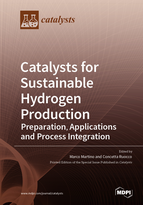Catalysts for Sustainable Hydrogen Production: Preparation, Applications and Process Integration
A special issue of Catalysts (ISSN 2073-4344). This special issue belongs to the section "Catalysis for Sustainable Energy".
Deadline for manuscript submissions: closed (30 April 2021) | Viewed by 61479
Special Issue Editors
Interests: catalysis; WGS; reforming; gasification; propane dehydrogenation; coating; structured catalysts
Special Issues, Collections and Topics in MDPI journals
Interests: heterogeneous catalysts; hydrogen production; reforming; renewables conversion
Special Issues, Collections and Topics in MDPI journals
Special Issue Information
Dear Colleagues,
In the last decades, the production of hydrogen has taken on a strategic role in energy transition and in the mobility of the future. On September 18th last year, the European Union’s Energy Ministers signed a policy document to support the development of sustainable hydrogen, the “Hydrogen Initiative”, with the aim of seizing the opportunities offered by hydrogen technology in the view of a carbon-free economy and to guarantee the safe and sustainable production of energy for the European Union. Hydrogen is the ideal energy vector: thanks to its energy value, it is considered the best alternative to the use of gasoline in automotive applications and, in the future, it could be used to provide power for our homes and offices. Hydrogen can be obtained from renewable or fossil sources and a wide variety of processes are involved in H2 production, such as reforming, partial oxidation, electrolysis, catalytic decomposition, and microbiological processes. The present Special Issue is devoted to recent developments in the preparation of catalysts and their applications in hydrogen production processes. This Special Issue welcomes research papers, short communications, and review papers related to innovative catalytic formulations and configurations, as well as process integrations.
Dr. Marco Martino
Dr. Concetta Ruocco
Guest Editors
Manuscript Submission Information
Manuscripts should be submitted online at www.mdpi.com by registering and logging in to this website. Once you are registered, click here to go to the submission form. Manuscripts can be submitted until the deadline. All submissions that pass pre-check are peer-reviewed. Accepted papers will be published continuously in the journal (as soon as accepted) and will be listed together on the special issue website. Research articles, review articles as well as short communications are invited. For planned papers, a title and short abstract (about 100 words) can be sent to the Editorial Office for announcement on this website.
Submitted manuscripts should not have been published previously, nor be under consideration for publication elsewhere (except conference proceedings papers). All manuscripts are thoroughly refereed through a single-blind peer-review process. A guide for authors and other relevant information for submission of manuscripts is available on the Instructions for Authors page. Catalysts is an international peer-reviewed open access monthly journal published by MDPI.
Please visit the Instructions for Authors page before submitting a manuscript. The Article Processing Charge (APC) for publication in this open access journal is 2700 CHF (Swiss Francs). Submitted papers should be well formatted and use good English. Authors may use MDPI's English editing service prior to publication or during author revisions.
Keywords
- hydrogen and biohydrogen production processes
- process integration
- new catalytic formulations and configurations
- sustainability and renewables
- low carbon technologies







